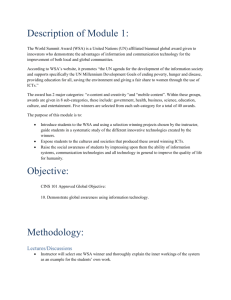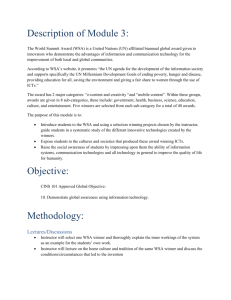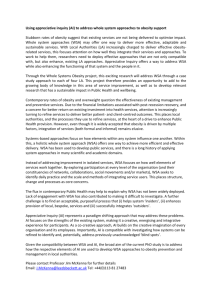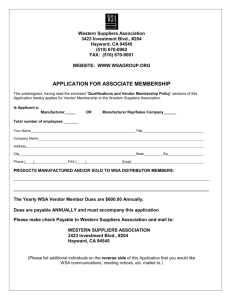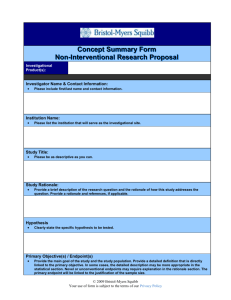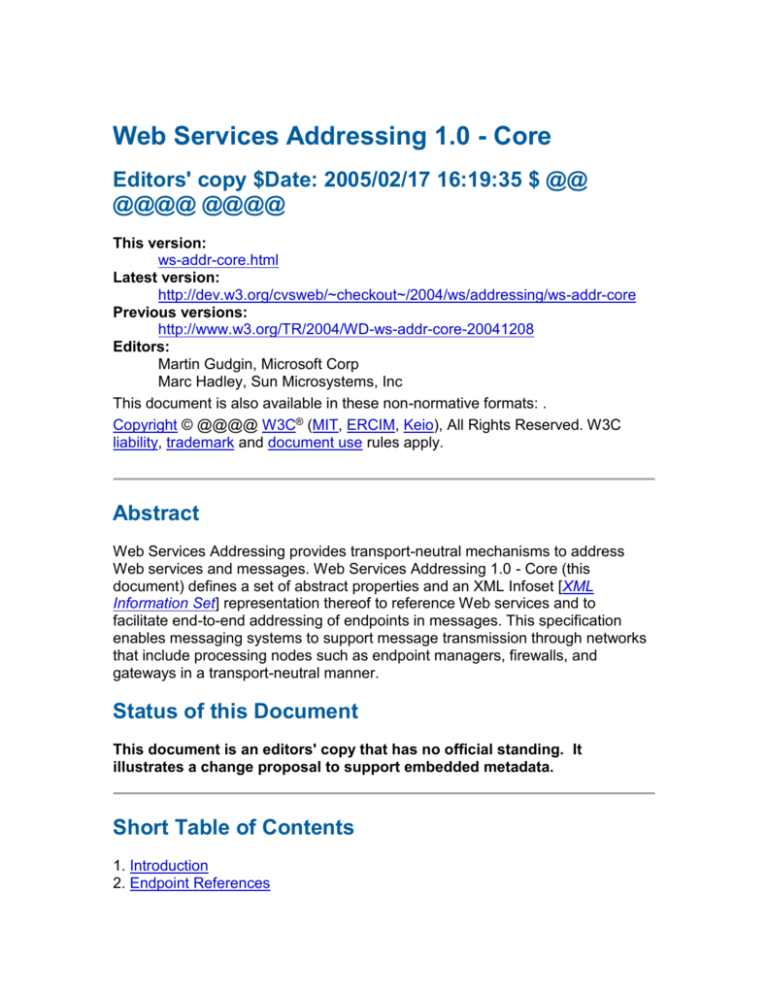
Web Services Addressing 1.0 - Core
Editors' copy $Date: 2005/02/17 16:19:35 $ @@
@@@@ @@@@
This version:
ws-addr-core.html
Latest version:
http://dev.w3.org/cvsweb/~checkout~/2004/ws/addressing/ws-addr-core
Previous versions:
http://www.w3.org/TR/2004/WD-ws-addr-core-20041208
Editors:
Martin Gudgin, Microsoft Corp
Marc Hadley, Sun Microsystems, Inc
This document is also available in these non-normative formats: .
Copyright © @@@@ W3C® (MIT, ERCIM, Keio), All Rights Reserved. W3C
liability, trademark and document use rules apply.
Abstract
Web Services Addressing provides transport-neutral mechanisms to address
Web services and messages. Web Services Addressing 1.0 - Core (this
document) defines a set of abstract properties and an XML Infoset [XML
Information Set] representation thereof to reference Web services and to
facilitate end-to-end addressing of endpoints in messages. This specification
enables messaging systems to support message transmission through networks
that include processing nodes such as endpoint managers, firewalls, and
gateways in a transport-neutral manner.
Status of this Document
This document is an editors' copy that has no official standing. It
illustrates a change proposal to support embedded metadata.
Short Table of Contents
1. Introduction
2. Endpoint References
3. Message Addressing Properties
4. References
A. Acknowledgements (Non-Normative)
B. Change Log (Non-Normative)
Table of Contents
1. Introduction
1.1 Notational Conventions
1.2 Namespaces
2. Endpoint References
2.1 Information Model for Endpoint References
2.2 Endpoint Reference XML Infoset Representation
2.3 Endpoint Reference Comparison
2.4 Endpoint Reference Lifecycle
3. Message Addressing Properties
3.1 XML Infoset Representation of Message Addressing Properties
3.1.1 Comparing URIs
3.2 Formulating a Reply Message
4. References
Appendices
A. Acknowledgements (Non-Normative)
B. Change Log (Non-Normative)
B.1 Changes Since First Working Draft
B.2 Changes Since Submission
1. Introduction
Web Services Addressing (WS-Addressing) defines two constructs, message
addressing properties and endpoint references, that normalize the information
typically provided by transport protocols and messaging systems in a way that is
independent of any particular transport or messaging system.
A Web service endpoint is a (referenceable) entity, processor, or resource to
which Web service messages can be addressed. Endpoint references convey
the information needed to address a Web service endpoint.
This specification defines a family of message addressing properties that convey
end-to-end message characteristics including references for source and
destination endpoints and message identity that allows uniform addressing of
messages independent of the underlying transport.
Both of these constructs are designed to be extensible and re-usable so that
other specifications can build on and leverage endpoint references and message
information headers.
The following example illustrates the use of these mechanisms in a SOAP 1.2
message being sent from http://example.com/business/client1 to
http://example.com/fabrikam/Purchasing:
Example 1-1. Use of message addressing properties in a SOAP 1.2 message.
(001) <S:Envelope xmlns:S="http://www.w3.org/2003/05/soap-envelope"
xmlns:wsa="http://www.w3.org/@@@@/@@/addressing">
(002)
<S:Header>
(003)
<wsa:MessageID>
(004)
http://example.com/6B29FC40-CA47-1067-B31D-00DD010662DA
(005)
</wsa:MessageID>
(006)
<wsa:ReplyTo>
(007)
<wsa:Address>http://example.com/business/client1</wsa:Address>
(008)
</wsa:ReplyTo>
(009)
<wsa:To>http://example.com/fabrikam/Purchasing</wsa:To>
(010)
<wsa:Action>http://example.com/fabrikam/SubmitPO</wsa:Action>
(011)
</S:Header>
(012)
<S:Body>
(013)
...
(014)
</S:Body>
(015) </S:Envelope>
Lines (002) to (011) represent the header of the SOAP message where the
mechanisms defined in the specification are used. The body is represented by
lines (012) to (014).
Lines (003) to (010) contain the message information header blocks. Specifically,
lines (003) to (005) specify the identifier for this message and lines (006) to (008)
specify the endpoint to which replies to this message should be sent as an
Endpoint Reference. Line (009) specifies the address URI of the ultimate receiver
of this message. Line (010) specifies an Action URI identifying expected
semantics.
1.1 Notational Conventions
The keywords "MUST", "MUST NOT", "REQUIRED", "SHALL", "SHALL NOT",
"SHOULD", "SHOULD NOT", "RECOMMENDED", "MAY", and "OPTIONAL" in
this document are to be interpreted as described in RFC 2119 [IETF RFC 2119].
When describing abstract data models, this specification uses the notational
convention used by the XML Infoset [XML Information Set]. Specifically, abstract
property names always appear in square brackets (e.g., [some property]).
When describing concrete XML schemas [XML Schema Structures, XML
Schema Datatypes], this specification uses the notational convention of WSSecurity [WS-Security]. Specifically, each member of an element's [children] or
[attributes] property is described using an XPath-like notation (e.g.,
/x:MyHeader/x:SomeProperty/@value1). The use of {any} indicates the presence
of an element wildcard (<xs:any/>). The use of @{any} indicates the presence of
an attribute wildcard (<xs:anyAttribute/>).
1.2 Namespaces
This specification uses a number of namespace prefixes throughout; they are
listed in Table 1-1. Note that the choice of any namespace prefix is arbitrary and
not semantically significant (see [XML Namespaces ]).
Table 1-1. Prefixes and Namespaces used in this specification
Prefix Namespace
S
http://www.w3.org/2003/05/soap-envelope
S11
http://schemas.xmlsoap.org/soap/envelope
wsa
http://www.w3.org/@@@@/@@/addressing
xs
http://www.w3.org/2001/XMLSchema
WS-Addressing may be used with SOAP [SOAP 1.2 Part 1: Messaging
Framework] as described in Web Services Addressing 1.0 - SOAP Binding[WSAddressing-SOAP]. WS-Addressing may be used with WSDL [WSDL 2.0]
described services as described in Web Services Addressing 1.0 - WSDL
Binding[WS-Addressing-WSDL]. Examples in this specification use an XML 1.0
[XML 1.0] representation but this is not a requirement.
All information items defined by WS-Addressing are identified by the XML
namespace URI [XML Namespaces]
"http://www.w3.org/@@@@/@@/addressing". A normative XML Schema [XML
Schema Structures, XML Schema Datatypes] document can be obtained by
dereferencing the XML namespace URI.
2. Endpoint References
This section defines the information model and syntax of an endpoint reference.
This specification introduces the endpoint reference, a construct designed to
support the following usage scenarios:
Dynamic generation and customization of service endpoint descriptions.
Referencing and description of specific service instances that are created
as the result of stateful interactions.
Flexible and dynamic exchange of endpoint information in tightly coupled
environments where communicating parties share a set of common
assumptions about specific policies or protocols that are used during the
interaction.
2.1 Information Model for Endpoint References
An endpoint reference consists of the following abstract properties:
[address] : URI (mandatory)
An address URI for the endpoint. This may be a network address or a
logical address.
[reference parameters] : xs:any (0..unbounded).
A reference may contain a number of individual parameters which are
associated with the endpoint to facilitate a particular interaction. Reference
parameters are element information items that are named by QName and
are required to properly interact with the endpoint. Reference parameters
are also provided by the issuer of the endpoint reference and are
otherwise assumed to be opaque to consuming applications. The use of
reference parameters is dependent upon the protocol binding and data
encoding used to interact with the endpoint. Web Services Addressing 1.0
- SOAP Binding[WS-Addressing-SOAP] describes the default binding for
the SOAP protocol.
[selected interface] : QName (0..1)
A QName identifying a description of the sequences of messages that a
service sends and/or receives, see Web Services Addressing 1.0 - WSDL
Binding[WS-Addressing-WSDL] for more details.
[service endpoint] : (QName, NCName (0..1)) (0..1)
A QName, NCName pair: the QName identifies a description of a set of
endpoints at which a particular Web service is deployed; the NCName
identifies one endpoint in particular. See Web Services Addressing 1.0 WSDL Binding[WS-Addressing-WSDL] for more details.
[metadata] : xsd:any (0..1)
A reference may contain metadata that describes the behavior, policies,
requirements and capabilities of the endpoint. Metadata may be included
in a reference to facilitate easier processing by a consuming application,
or because the metadata was dynamically generated. However, such
metadata is not authoritative and may be stale or incoherent with the
metadata associated with the endpoint at the time when the interaction
occurs.
2.2 Endpoint Reference XML Infoset Representation
This section defines an XML Infoset-based representation for an endpoint
reference as both an XML type (wsa:EndpointReferenceType) and as an XML
element (<wsa:EndpointReference>).
The wsa:EndpointReferenceType type is used wherever a Web service endpoint
is referenced. The following describes the contents of this type:
Example 2-1. Structure of the wsa:EndpointReference element.
<wsa:EndpointReference>
<wsa:Address>xs:anyURI</wsa:Address>
<wsa:ReferenceParameters>... </wsa:ReferenceParameters> ?
<wsa:Metadata>
<wsa:InterfaceName>xs:QName</wsa:InterfaceName> ?
<wsa:ServiceName
EndpointName="xs:NCName"?>xs:QName</wsa:ServiceName> ?
<xs:any/>*
</wsa:Metadata>?
<xs:any/>*
</wsa:EndpointReference>
The following describes the attributes and elements listed in the schema
overview above:
/wsa:EndpointReference
This represents some element of type wsa:EndpointReferenceType. This
example uses the predefined <wsa:EndpointReference> element, but any
element of type wsa:EndpointReferenceType may be used.
/wsa:EndpointReference/wsa:Address
This REQUIRED element (of type xs:anyURI) specifies the [address]
property of the endpoint reference. This address may be a logical address
for the service endpoint.
/wsa:EndpointReference/wsa:ReferenceParameters/
This OPTIONAL element contains the elements that convey the [reference
parameters] of the reference.
/wsa:EndpointReference/wsa:ReferenceParameters/{any}
Each child element of ReferenceParameters represents an individual
[reference parameter].
/wsa:EndpointReference/wsa:Metadata/wsa:InterfaceName
This OPTIONAL element (of type xs:Qname) specifies the value of the
[selected interface] property of the endpoint reference, see Web Services
Addressing 1.0 - WSDL Binding[WS-Addressing-WSDL] for more details..
/wsa:EndpointReference/wsa:Metadata
This OPTIONAL element contains metadata that is relevant to the
interaction with the endpoint.
/wsa:EndpointReference/wsa:Metadata/wsa:ServiceName
This OPTIONAL element (of type xs:QName) specifies the value of the
[service endpoint] property, see Web Services Addressing 1.0 - WSDL
Binding[WS-Addressing-WSDL] for more details..
/wsa:EndpointReference/wsa:Metadata/wsa:ServiceName/@EndpointName
This OPTIONAL attribute (of type xs:NCName) specifies the name of a
particular endpoint, see Web Services Addressing 1.0 - WSDL
Binding[WS-Addressing-WSDL] for more details.
/wsa:EndpointReference/wsa:Metadata/@{any}
This is an extensibility mechanism to allow additional attributes to be
specified. Some examples in this specification show use of this
extensibility point to include a wsdlLocation[WSDL 2.0] attribute to provide
a hint for the location of a WSDL description of the [selected interface] and
[service endpoint] properties.
/wsa:EndpointReference/wsa:Metadata/{any}
Each child element of Metadata represents a piece of metadata relevant
to the endpoint.
/wsa:EndpointReference/{any}
This is an extensibility mechanism to allow additional elements to be
specified.
/wsa:EndpointReference/@{any}
This is an extensibility mechanism to allow additional attributes to be
specified.
The following shows an example endpoint reference. As indicated in it’s
[metadata], this element references the [selected interface] "fabrikam:Inventory"
at the endpoint URI "http://example.com/www.fabrikam/acct". Note the use of the
WSDL[WSDL 2.0] wsdlLocation attribute.
Example 2-2. Example endpoint reference.
<wsa:EndpointReference
xmlns:wsa="http://www.w3.org/@@@@/@@/addressing"
xmlns:fabrikam="http://example.com/fabrikam"
xmlns:wsdli="http://www.w3.org/2004/08/wsdl-instance"
wsdli:wsdlLocation="http://example.com/fabrikam
http://example.com/fabrikam/fabrikam.wsdl">
<wsa:Address>http://example.com/fabrikam/acct</wsa:Address>
<wsa:Metadata>
<wsa:InterfaceName>fabrikam:Inventory</wsa:InterfaceName>
</wsa:Metadata>
</wsa:EndpointReference>
2.3 Endpoint Reference Comparison
During the course of Web services interactions applications may receive multiple
endpoint references describing the endpoints it needs to interact with. Different
copies of an endpoint reference may also be received over time.
The following rule clarifies the relation between the behaviors of the endpoints
represented by two endpoint references with the same [address];
The two endpoints accept the same sets of messages, and follow and
require the same set of policies. That is, the XML Schema, WSDL, and
policy and other metadata applicable to the two references are the same.
However, the metadata embedded in each of the EPRs MAY differ, as the
metadata carried by an EPR is not necessarily a complete statement of the
metadata pertaining to the endpoint. Moreover, while embedded metadata is
necessarily valid at the time the EPR is initially created it may become stale at a
later point in time.
To deal with conflicts between the embedded metadata of two EPRs, or between
embedded metadata and metadata obtained from a different source, or to
ascertain the current validity of embedded metadata, mechanisms that are
outside of the scope of this specification, such as EPR life cycle information [see
2.4 Endpoint Reference Lifecycle] or retrieval of metadata from an authoritative
source, SHOULD be used.
The [address] properties of two endpoint references are compared according to
Section 6 of [IETF RFC 3986].
Therefore, a consuming application should assume that different XML Schemas,
WSDL definitions and policies apply to endpoint references whose addresses
differ.
2.4 Endpoint Reference Lifecycle
This specification does not define a lifecycle model for endpoint references and
does not address the question of time-to-live for endpoint references. Other
specifications that build on or use WS-Addressing may define a lifecycle model
for endpoint references created according to that specification.
3. Message Addressing Properties
This section defines the information model and syntax of message addressing
properties.
Message addressing properties provide references for the endpoints involved in
an interaction. The use of these properties to support specific interaction is in
general defined by both the semantics of the properties themselves and the
implicit or explicit contract that governs the message exchange. If explicitly
available, this contract can take different forms including but not being limited to
WSDL MEPs and interfaces; business processes and e-commerce
specifications, among others, can also be used to define explicit contracts
between the parties. The basic interaction pattern from which all others are
composed is "one way". In this pattern a source sends a message to a
destination without any further definition of the interaction. "Request Reply" is a
common interaction pattern that consists of an initial message sent by a source
endpoint (the request) and a subsequent message sent from the destination of
the request back to the source (the reply). A reply in this case can be either an
application message, a fault, or any other message. Note, however, that reply
messages may be sent as part of other message exchanges as well, and are not
restricted to the usual single Request, single Reply pattern, or to a particular
WSDL MEP. The contract between the interacting parties may specify that
multiple or even a variable number or replies be delivered.
Message addressing properties collectively augment a message with the
following abstract properties to support one way, request reply, and any other
interaction pattern:
[destination] : URI (mandatory)
The address of the intended receiver of this message.
[source endpoint] : endpoint reference (0..1)
Reference of the endpoint where the message originated from.
[reply endpoint] : endpoint reference (0..1)
An endpoint reference for the intended receiver for replies to this
message. If a reply is expected, a message MUST contain a [reply
endpoint]. The sender MUST use the contents of the [reply endpoint] to
formulate the reply message as defined in 3.2 Formulating a Reply
Message. If this property is present, the [message id] property is
REQUIRED.
[fault endpoint] : endpoint reference (0..1)
An endpoint reference for the intended receiver for faults related to this
message. When formulating a fault message as defined in 3.2
Formulating a Reply Message, the sender MUST use the contents of the
[fault endpoint], when present, of the message being replied to to
formulate the fault message. If this property is present, the [message id]
property is REQUIRED.
[action] : URI (mandatory)
An identifier that uniquely (and opaquely) identifies the semantics implied
by this message.
It is RECOMMENDED that value of the [action] property is a URI
identifying an input, output, or fault message within a WSDL port type. An
action may be explicitly or implicitly associated with the corresponding
WSDL definition. Web Services Addressing 1.0 - WSDL Binding[WSAddressing-WSDL] describes the mechanisms of association. Finally, if in
addition to the [action] property, a SOAP Action URI is encoded in a
request, the URI of the SOAP Action MUST be the same as the one
specified by the [action] property.
[message id] : URI (0..1)
A URI that uniquely identifies this message in time and space. No two
messages with a distinct application intent may share a [message id]
property. A message MAY be retransmitted for any purpose including
communications failure and MAY use the same [message id] property.
The value of this property is an opaque URI whose interpretation beyond
equivalence is not defined in this specification. If a reply is expected, this
property MUST be present.
[relationship] : (URI, URI) (0..unbounded)
A pair of values that indicate how this message relates to another
message. The type of the relationship is identified by a URI. The related
message is identified by a URI that corresponds to the related message's
[message id] property. The message identifier URI may refer to a specific
message, or be the following well-known URI that means "unspecified
message": "http://www.w3.org/@@@@/@@/addressing/id/unspecified"
This specification has one predefined relationship type as shown in Table
3-1.
Table 3-1. Predefined [relationship] values
URI
Description
Indicates that this is a
"http://www.w3.org/@@@@/@@/addressing/reply" reply to the message
identified by the URI.
A reply message MUST contain a [relationship] property consisting of the
predefined reply URI and the message id property of the request
message.
The dispatching of incoming messages is based on two message properties: the
mandatory "destination" and "action" fields indicate the target processing location
and the verb or intent of the message respectively.
Due to the range of network technologies currently in wide-spread use (e.g.,
NAT, DHCP, firewalls), many deployments cannot assign a meaningful global
URI to a given endpoint. To allow these "anonymous" endpoints to initiate
message exchange patterns and receive replies, WS-Addressing defines the
following well-known URI for use by endpoints that cannot have a stable,
resolvable URI: "http://www.w3.org/@@@@/@@/addressing/role/anonymous"
Requests whose [reply endpoint], [source endpoint] and/or [fault endpoint] use
this address MUST provide some out-of-band mechanism for delivering replies or
faults (e.g. returning the reply on the same transport connection). This
mechanism may be a simple request/reply transport protocol (e.g., HTTP GET or
POST). This URI MAY be used as the [destination] for reply messages and
SHOULD NOT be used as the [destination] in other circumstances.
3.1 XML Infoset Representation of Message Addressing
Properties
Message addressing properties provide end-to-end characteristics of a message
that can be easily secured as a unit. These properties are immutable and not
intended to be modified along a message path.
The following describes the XML Infoset representation of message addressing
properties:
Example 3-1. XML Infoset representation of message addressing properties.
<wsa:MessageID> xs:anyURI </wsa:MessageID>
<wsa:RelatesTo RelationshipType="..."?>xs:anyURI</wsa:RelatesTo>
<wsa:To>xs:anyURI</wsa:To>
<wsa:Action>xs:anyURI</wsa:Action>
<wsa:From>endpoint-reference</wsa:From>
<wsa:ReplyTo>endpoint-reference</wsa:ReplyTo>
<wsa:FaultTo>endpoint-reference</wsa:FaultTo>
The following describes the attributes and elements listed in the schema
overview above:
/wsa:MessageID
This OPTIONAL element (of type xs:anyURI) conveys the [message id]
property. This element MUST be present if wsa:ReplyTo or wsa:FaultTo is
present.
/wsa:RelatesTo
This OPTIONAL (repeating) element information item contributes one
abstract [relationship] property value, in the form of a (URI, URI) pair. The
[children] property of this element (which is of type xs:anyURI) conveys
the [message id] of the related message. This element MUST be present if
the message is a reply.
/wsa:RelatesTo/@RelationshipType
This OPTIONAL attribute (of type xs:anyURI) conveys the relationship
type as a URI. When absent, the implied value of this attribute is
"http://www.w3.org/@@@@/@@/addressing/reply".
/wsa:ReplyTo
This OPTIONAL element (of type wsa:EndpointReferenceType) provides
the value for the [reply endpoint] property. This element MUST be present
if a reply is expected. If this element is present, wsa:MessageID MUST be
present.
/wsa:From
This OPTIONAL element (of type wsa:EndpointReferenceType) provides
the value for the [source endpoint] property.
/wsa:FaultTo
This OPTIONAL element (of type wsa:EndpointReferenceType) provides
the value for the [fault endpoint] property. If this element is present,
wsa:MessageID MUST be present.
/wsa:To
This OPTIONAL element (of type xs:anyURI) provides the value for the
[destination] property. If this element is NOT present then the value of the
[destination] property is
"http://www.w3.org/@@@@/@@/addressing/role/anonymous". Otherwise
the [children] of this element convey the value of this property.
/wsa:Action
This REQUIRED element of type xs:anyURI conveys the [action] property.
The [children] of this element convey the value of this property.
3.1.1 Comparing URIs
The values of the Message Addressing Properties [action], [message id], and
[relationship] are absolute URIs. The purpose of these URIs is primarily
identification, rather than resource retrieval. As such, simple string comparison,
as indicated in Internationalized Resource IdentifiersIETF RFC 3987 section
5.3.1, is sufficient to determine equivalence of these URIs.
3.2 Formulating a Reply Message
The reply to a WS-Addressing compliant request message MUST be compliant
to WS-Addressing and is constructed according to the following rules:
1. Select the appropriate EPR:
o If the reply is a normal message, select the EPR from the incoming
message's [reply endpoint] message addressing property. If none is
present, the processor MUST fault.
o Otherwise, if the reply is a fault message and the incoming
message's [fault endpoint] message addressing property is not
empty, select the EPR from this property. If the [fault endpoint]
property is empty, the behavior of the recipient of the incoming
message is unconstrained by this specification.
2. Populate the reply message's message addressing properties:
o [destination]: this property takes the value of the selected EPR's
[address] property
o [relationship]: a new pair of URIs is added to this value as follows;
the relationship type is the predefined reply URI
"http://www.w3.org/@@@@/@@/addressing/reply" and the related
message's identifier is the [message id] property value from the
message being replied to; other relationships MAY be expressed in
this property
o [reference parameters]: this property takes the value of the selected
EPR's [reference parameters] property
The following example illustrates a request message containing message
addressing properties serialized as header blocks in a SOAP 1.2 message:
Example 3-2. Example request message.
<S:Envelope xmlns:S="http://www.w3.org/2003/05/soap-envelope"
xmlns:wsa="http://www.w3.org/@@@@/@@/addressing">
<S:Header>
<wsa:MessageID>http://example.com/someuniquestring
</wsa:MessageID>
<wsa:ReplyTo>
<wsa:Address>http://example.com/business/client1</wsa:Address>
</wsa:ReplyTo>
<wsa:To S:mustUnderstand="1">mailto:fabrikam@example.com</wsa:To>
<wsa:Action>http://example.com/fabrikam/mail/Delete</wsa:Action>
</S:Header>
<S:Body>
<f:Delete xmlns:f="http://example.com/fabrikam">
<maxCount>42</maxCount>
</f:Delete>
</S:Body>
</S:Envelope>
This message would have the following property values:
[destination]: "mailto:fabrikam@example.com"
[reply endpoint]: The endpoint with [address]
"http://example.com/business/client1"
[action]: "http://example.com/fabrikam/mail/Delete"
[message id]: "http://example.com/someuniquestring"
The following example illustrates a reply to the above message:
Example 3-3. Example response message.
<S:Envelope
xmlns:S="http://www.w3.org/2003/05/soap-envelope"
xmlns:wsa="http://www.w3.org/@@@@/@@/addressing">
<S:Header>
<wsa:MessageID>
http://example.com/someotheruniquestring
</wsa:MessageID>
<wsa:RelatesTo>
http://example.com/someuniquestring
</wsa:RelatesTo>
<wsa:To S:mustUnderstand="1">
http://example.com/business/client1
</wsa:To>
<wsa:Action>http://example.com/fabrikam/mail/DeleteAck</wsa:Action>
</S:Header>
<S:Body>
<f:DeleteAck xmlns:f="http://example.com/fabrikam"/>
</S:Body>
</S:Envelope>
This message would have the following property values:
[destination]: "http://example.com/business/client1"
[action]: "http://example.com/fabrikam/mail/DeleteAck"
[message id]: "http://example.com/someotheruniquestring"
[relationship]: ("http://www.w3.org/@@@@/@@/addressing/reply",
"http://example.com/someuniquestring")
4. References
[WS-Addressing-SOAP]
Web Services Addressing 1.0 - SOAP Binding, M. Gudgin, M. Hadley,
Editors.
[WS-Addressing-WSDL]
Web Services Addressing 1.0 - WSDL Binding, M. Gudgin, M. Hadley,
Editors.
[WSDL 2.0]
Web Services Description Language 2.0, R. Chinnici, M. Gudgin, J. J.
Moreau, J. Schlimmer, S. Weerawarana, Editors. World Wide Web
Consortium, 3 August 2004. This version of the WSDL 2.0 specification is
http://www.w3.org/TR/2004/WD-wsdl20-20040803. The latest version of
WSDL 2.0 is available at http://www.w3.org/TR/wsdl20.
[IETF RFC 2119]
Key words for use in RFCs to Indicate Requirement Levels, S. Bradner.
Internet Engineering Task Force, June 1999. Available at
http://www.ietf.org/rfc/rfc2119.txt.
[IETF RFC 3986]
T. Berners-Lee, et al, "Uniform Resource Identifier (URI): Generic
Syntax,", W3C/MIT, January 2005. Available at
http://www.ietf.org/rfc/rfc3986.txt (See http://www.ietf.org/rfc/rfc3986.txt.)
[XML 1.0]
Extensible Markup Language (XML) 1.0 (Second Edition), T. Bray, J.
Paoli, C. M. Sperberg-McQueen, and E. Maler, Editors. World Wide Web
Consortium, 10 February 1998, revised 6 October 2000. This version of
the XML 1.0 Recommendation is http://www.w3.org/TR/2000/REC-xml20001006. The latest version of XML 1.0 is available at
http://www.w3.org/TR/REC-xml.
[XML Namespaces]
Namespaces in XML, T. Bray, D. Hollander, and A. Layman, Editors.
World Wide Web Consortium, 14 January 1999. This version of the XML
Information Set Recommendation is http://www.w3.org/TR/1999/REC-xmlnames-19990114. The latest version of Namespaces in XML is available
at http://www.w3.org/TR/REC-xml-names.
[XML Information Set]
XML Information Set, J. Cowan and R. Tobin, Editors. World Wide Web
Consortium, 24 October 2001. This version of the XML Information Set
Recommendation is http://www.w3.org/TR/2001/REC-xml-infoset-
20011024. The latest version of XML Information Set is available at
http://www.w3.org/TR/xml-infoset.
[XML Schema Structures]
XML Schema Part 1: Structures, H. Thompson, D. Beech, M. Maloney,
and N. Mendelsohn, Editors. World Wide Web Consortium, 2 May 2001.
This version of the XML Schema Part 1 Recommendation is
http://www.w3.org/TR/2001/REC-xmlschema-1-20010502. The latest
version of XML Schema Part 1 is available at
http://www.w3.org/TR/xmlschema-1.
[XML Schema Datatypes]
XML Schema Part 2: Datatypes, P. Byron and A. Malhotra, Editors. World
Wide Web Consortium, 2 May 2001. This version of the XML Schema Part
2 Recommendation is http://www.w3.org/TR/2001/REC-xmlschema-220010502. The latest version of XML Schema Part 2 is available at
http://www.w3.org/TR/xmlschema-2.
[SOAP 1.2 Part 1: Messaging Framework]
SOAP Version 1.2 Part 1: Messaging Framework, M. Gudgin, M. Hadley,
N. Mendelsohn, J-J. Moreau, H. Frystyk Nielsen, Editors. World Wide Web
Consortium, 24 June 2003. This version of the "SOAP Version 1.2 Part 1:
Messaging Framework" Recommendation is
http://www.w3.org/TR/2003/REC-soap12-part1-20030624/. The latest
version of "SOAP Version 1.2 Part 1: Messaging Framework" is available
at http://www.w3.org/TR/soap12-part1/.
[WSDL 1.1]
E. Christensen, et al, Web Services Description Language (WSDL) 1.1,
March 2001.
[WS-Security]
OASIS, Web Services Security: SOAP Message Security, March 2004.
[IETF RFC 3987]
M. Duerst, M. Suignard, "Internationalized Resource Identifiers (IRIs)",
January 2005. Available at http://www.ietf.org/rfc/rfc3987. (See
http://www.ietf.org/rfc/rfc3987.)
A. Embedding WSDL metadata (non-normative)
WSDL 1.1 or 2.0 definitions can be embedded in the metadata section of an EPR
to provide a consuming application with WSDL information that applies to the
referenced endpoint. To do so, the creator of an EPR MAY include a WSDL 2.0
description element (or a WSDL 1.1 definitions element) in the metadata property
of the EPR. The semantics of the embedded WSDL is as defined by the WSDL
2.0 or 1.1 specifications.
In particular, embedding a WSDL service component description MAY be used
by EPR issuers to indicate the presence of alternative addresses and protocol
bindings to access the referenced endpoint. The alternatives are provided by the
different endpoints of the embedded service. In the case of WSDL 1.1, additional
ports may be conveyed by the WSDL 1.1 service definition which are not
alternative access channels to the endpoint. In that case, if the [interface] or
[service endpoint] properties are specified, only the ports with the same interface
as that which applies to the EPR are to be considered alternative access
channels.
If the [service endpoint] property appears in the EPR’s [metadata] and an
embedded WSDL service component is also provided inside a descriptions or
definitions component, then the [service endpoint] information MUST match the
name of (one or more of) the WSDL service(s) included therein; the endpoint
(port) name MUST match as well if present. The behavior of an EPR consumer
when the [service endpoint] doesn’t match an embedded description is
undefined.
Example A-1. An EPR containing WSDL 2.0 metadata.
<wsa:EndpointReference
xmlns:wsa="http://www.w3.org/@@@@/@@/addressing">
<wsa:Address>http://example.com/fabrikam/acct</wsa:Address>
<wsa:Metadata
xmlns:wsdli="http://www.w3.org/@@@@/@@/wsdl-instance"
wsdli:wsdlLocation="http://example.com/fabrikam
http://example.com/fabrikam/fabrikam.wsdl">
<wsdl20:description
targetNamespace=="http://example.com/fabrikam"
xmlns:fabrikam="http://example.com/fabrikam"
xmlns:abc="http://www.abccorp.com/"
xmlns:wsdl20="http://www.w3.org/2004/12/wsdl">
<wsdl20:import namespace=”http://example.com/fabrikam/”
location=”http://example.com/fabrikam/fabrikam.wsdl/”/>
<wsdl20:import namespace="http://www.abccorp.com/"
location="http://www.abccorp.com/abc.wsdl"/>
<wsdl20:service name="InventoryService"
interface="fabrikam:Inventory">
<wsdl20:endpoint name="ep1" binding="abc:soap-httpbinding"
address="http://example.com/fabrikam/acct"/>
<wsdl20:endpoint name="ep2" binding="abc:iiop"
address="..."/>
<wsdl20:endpoint name="ep3"
binding="abc:soap-http-binding"
address="http://alt.example.com/fabrikam/acct"/>
</wsdl20:service>
</wsdl20:description>
</wsa:Metadata>
</wsa:EndpointReference>
Example A-2. An EPR containing WSDL 1.1 metadata.
<wsa:EndpointReference
xmlns:wsa="http://www.w3.org/@@@@/@@/addressing">
<wsa:Address>http://example.com/fabrikam/acct</wsa:Address>
<wsa:Metadata>
<wsdl11:definitions
targetNamespace="http://example.com/fabrikam"
xmlns:fabrikam="http://example.com/fabrikam"
xmlns:abc="http://www.abccorp.com/"
xmlns:soap="http://schemas.xmlsoap.org/wsdl/soap/"
xmlns:iiop="http://www.iiop.org/"
xmlns:wsdl11="http://www.w3.org/@@@@/@@/wsdl">
<wsdl11:import namespace="http://example.com/fabrikam"
location="http://example.com/fabrikam/fabrikam.wsdl"/>
<wsdl11:import namespace="http://www.abccorp.com/"
location="http://www.abccorp.com/abc.wsdl"/>
<wsdl11:service name="InventoryService">
<wsdl11:port name="ep1" binding="abc:soap-http-binding">
<soap:address
location="http://example.com/fabrikam/acct"/>
</wsdl11:port>
<wsdl11:port name="ep2" binding="abc:iiop">
<iiop:address location="..."/>
</wsdl11:service>
</wsdl11:definitions>
</wsa:Metadata>
</wsd:EndpointReference>
B. Acknowledgements (Non-Normative)
This document is the work of the W3C Web Service Addressing Working Group.
Members of the Working Group are (at the time of writing, and by alphabetical
order): Abbie Barbir (Nortel Networks), Rebecca Bergersen (IONA Technologies,
Inc.), Andreas Bjärlestam (ERICSSON), Ugo Corda (SeeBeyond Technology
Corporation), Francisco Curbera (IBM Corporation), Glen Daniels (Sonic
Software), Paul Downey (BT), Jacques Durand (Fujitsu Limited), Michael Eder
(Nokia), Robert Freund (Hitachi, Ltd.), Yaron Goland (BEA Systems, Inc.), Martin
Gudgin (Microsoft Corporation), Arun Gupta (Sun Microsystems, Inc.), Hugo
Haas (W3C/ERCIM), Marc Hadley (Sun Microsystems, Inc.), David Hull (TIBCO
Software, Inc.), Yin-Leng Husband (HP), Anish Karmarkar (Oracle Corporation),
Paul Knight (Nortel Networks), Philippe Le Hégaret (W3C/MIT), Mark Little
(Arjuna Technologies Ltd.), Jonathan Marsh (Microsoft Corporation), Jeff
Mischkinsky (Oracle Corporation), Nilo Mitra (ERICSSON), Eisaku Nishiyama
(Hitachi, Ltd.), Mark Nottingham (BEA Systems, Inc.), Ales Novy (Systinet Inc.),
David Orchard (BEA Systems, Inc.), Mark Peel (Novell, Inc.), Harris Reynolds
(webMethods, Inc.), Tony Rogers (Computer Associates), Tom Rutt (Fujitsu
Limited), Rich Salz (DataPower Technology, Inc.), Davanum Srinivas (Computer
Associates), Jiri Tejkl (Systinet Inc.), Greg Truty (IBM Corporation), Steve Vinoski
(IONA Technologies, Inc.), Pete Wenzel (SeeBeyond Technology Corporation),
Steve Winkler (SAP AG), Ümit Yalçınalp (SAP AG).
Previous members of the Working Group were: @@@.
The people who have contributed to discussions on public-wsaddressing@w3.org are also gratefully acknowledged.
C. Change Log (Non-Normative)
C.1 Changes Since First Working Draft
Date
Editor
Description
200502-17 @ mhadley Added resolution to issue 44
16:16
200502-15 @ mhadley Added resolution to issue 46
22:53
2005Removed several occurances of the word 'identify' when used
02-01 @ mhadley with endpoint references. Replaced with 'reference' or
19:49
'address' as appropriate.
200501-23 @ mgudgin Incorporated resolution of issue i014; edits to Section 2.3
21:13
200501-23 @ mgudgin Incorporated resolution of issue i006; made wsa:To optional
20:52
2005Incorporated resolution of Issue i001 by removing Reference
01-23 @ mgudgin
Properties
19:32
200501-17 @ mgudgin Incorporated Paco's proposal for resolving Issue 038
02:13
200501-16 @ mgudgin s/PortType/InterfaceName in certain examples
22:40
200412-17 @ mhadley Improved readability of introduction
16:08
200412-16 @ mhadley Added resolution to issue 19 - WSDL version neutrality
18:20
200412-16 @ mhadley Added issue 33 resolution
16:50
200412-14 @ mhadley Switched back to edcopy formatting
20:10
Enhanced auto-changelog generation to allow specification of
2004data ranges for logs. Split change log to show changes
12-14 @ mhadley
between early draft and first working draft and changes since
20:02
first working draft.
2004Added resolutions for issues 12 (EPR lifecycle), 37
12-14 @ mhadley (relationship from QName to URI) and 39 (spec name
18:13
versioning)
C.2 Changes Since Submission
Date
Editor
Description
2004-11Updated titles of examples. Fixed table formatting and
23 @
mhadley references. Replaced uuid URIs with http URIs in examples.
21:38
Added document status.
2004-1122 @
mhadley Removed reference to WS-Policy
15:40
2004-1115 @
mhadley Fixed some inter and intra spec references.
19:43
2004-1112 @
mgudgin Removed TBD sections
21:19
2004-1111 @
mgudgin Added some TBD sections
18:31
Second more detailed run through to separate core, SOAP
2004-11and WSDL document contents. Removed dependency on
07 @
mhadley
WS-Policy. Removed references to WS-Trust and WS02:03
SecurityPolicy
2004-11Removed static change log and added dynamically
02 @
mhadley
generated change log from cvs.
22:25
2004-1028 @
mhadley Initial cut of separating specification into core, soap and wsdl
17:05

